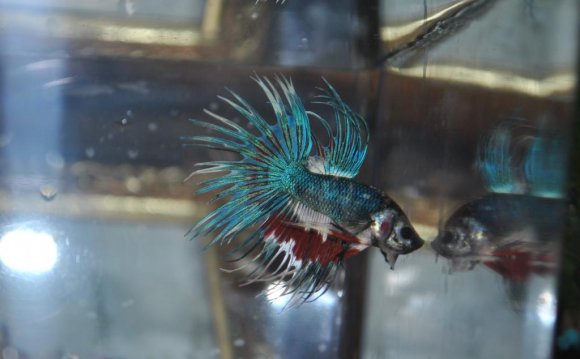
Crowntail betta fish or simply known as Betta is a popular species of freshwater fish. It is also known as the Siamese fighting fish or the Betta spenders. The ancestors of this fish are believed to be native to the rice paddies of Thailand and Cambodia. This colorful fish is very much in demand because of their beautiful structure and moreover they are easy to breed.
Taking Care of the Fish
It is not that difficult to take care of a betta fish. Just follow the steps given below and this colorful fish will be an added attraction to any home.
- The jar which is going to be used to keep the betta fish should have a lot of room for the fish to move in. The fish are very active in nature and they need huge space to dwell. It is recommended that the jar or the aquarium should not be small, otherwise the fish will keep bumping and tearing off its scales and fins.
- Betta fish will survive in the cleanest water that you can provide it. These fish don't require a filtration system, but it is necessary that tank water should be changed every three days, so the fish can stay healthy and clean.
- Never place more than one male fish in a single fish tank, they aren't called fighting fish for nothing. They actually fight with each other and they fight till one of the fish dies. An adult fish can be placed with catfish and algae eaters as they form a healthy team.
- Using a turkey baster to clean the waste particles from the water is the best way to clean the fish tank. Allowing the waste materials to settle down at the bottom of the jar, will make the water dirty and the water will emit a foul odor.
- The tank's PH level should be exactly 7.0. Get the PH level of the water checked with the help of a PH testing kit, which is available in the local pet store. Fish owners can also buy solutions that help increase or decrease the level of PH in the water.
- Never wash aquarium things such as plants, rocks or some gravel stones with soap. It becomes difficult to rinse soap from these things, as a result of which the soap content can kill your fish. For cleaning all these objects use warm water and an abrasive brush.
- Always keep your aquarium or jar covered. This fighting fish is very aggressive in nature and likes to jump around. It is quite possible that it could land up outside the jar.
- Feed them live food such as frozen blood worms and brine shrimp. Betta pellets are also their favorite food, betta pellets can be purchased at the local pet store.
- Never decorate the jar or an aquarium with small rocks, the betta fish could get stuck in them. Care for the fish by providing them a smooth flat surface, so these is no risk to their life.
- Lastly, treat the pet fish as a living thing. Feed it from time to time, if something is wrong take it to the vet and clean its home regularly.
- Betta fish get sick very easily. But if proper care and a hygienic environment is provided, the fish is bound to live a long and healthy life.
- The life span of betta fish is 2 to 3 years. In some rare cases, the fighting fish has also lived for 5 years.
- A betta fish has floating fins and a straight spine. The fighting fish is available in more than 25 colors and the most preferred ones are red, orange, blue, green, purple, black and white.
- A male betta fish will expand its flares when it feels threatened.
- Never keep more than one male betta fish together, they have a natural tendency to fight and they don't stop until one of them is killed.
- The female betta fish is thin than the male betta fish.
- There is a unique pattern of betta fish breeding. The male fish constructs a nest among the leaves of floating plants and the eggs are fertilized later by the males.
Names for Blue Betta Fish
- Ocean
- Moby
- Wave
- Barracuda
- Shark
- Mo
- Charlie
- Chas
- Flare
- Goldie
- Sunshine
- Sunny
- Chiffon
- Golden Rod
- Rose
- Papaya
- Tomato
- Teal
- Sienna
- Coral
- Cyan
- Cornflower
- Magenta
- Salmon
- Turquoise
- Violet
- Firebrick
Source: www.buzzle.com









